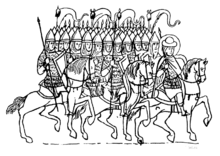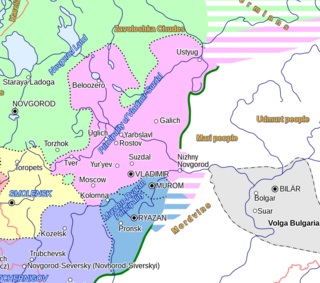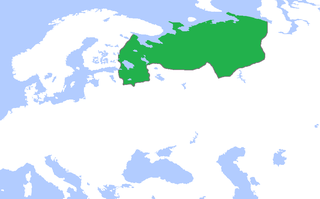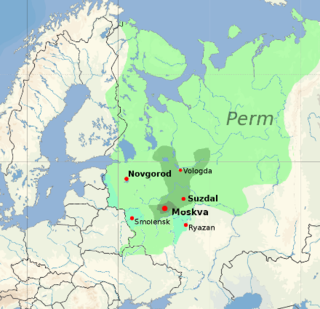
The military of Kievan Rus' served as the armed forces of Kievan Rus' between the 9th to 13th century. It was mainly characterised by infantry armies of town militia that were supported by druzhyna cavalry.

The military of Kievan Rus' served as the armed forces of Kievan Rus' between the 9th to 13th century. It was mainly characterised by infantry armies of town militia that were supported by druzhyna cavalry.

Tribal militia known as voyi formed the basis of the army in Kievan Rus' [1] until the tax reform of Olga of Kiev in the middle of the 10th century. [2] In the subsequent period, under Svyatoslav I of Kiev and Volodimer I of Kiev, druzhyna played a dominant role. [3] It consisted of senior members – the boyars – along with the rank-and-file ‘youths’ ("otroki").[ citation needed ]
The regiments of city militia, raised by the decision of the veche, [4] were formed in the 11th century. These regiments received weapons and horses for a campaign from the prince.[ citation needed ]

Before Mongol invasion of Kievan Rus' in the 13th century, a Prince would be accompanied by his druzhyna, a small retinue of heavy cavalry, [5] who would often fight dismounted (eq. Battle on the Ice). Massively heavy armour was used, mostly Scandinavian-style. [6] However, these squads, as a rule, did not exceed the number of several hundred men, and were unsuitable for united actions under a single command. [7]
At the same time, the main part of the Kievan Rus' army was the militia infantry. It was inferior to druzhyna in armament and the ability to own it. The militia used axes and hunting spears ("rogatina"). Swords were rarely used, and they had no armour other than plain clothes and fur hats. [5]
For the infantry, consisted of poorly armed peasants and tradesmen, numbers are uncertain. The only specific numbers mentioned for the Rus are 1,700 men of Evpaty Kolovrat [8] (The Tale of the Destruction of Ryazan) and 3,000, men under Voivode Dorozh [9] (Battle of the Sit River). However, these were exceptionally large numbers for Rus standards at the time. In 1242, Prince Alexander Nevski in Novgorod could muster no more than 1,000 druzhyna and 2,000 militia for the Battle on the Ice. [10] So, it is safe to estimate that, on average, a Rus' prince had hundreds of warriors in his retinue, rather than thousands.[ citation needed ]
During the Mongol invasion of Kievan Rus' ( 1223, 1237–1241), many cities including Kiev were sacked, and the state definitively split into many independent Rus' principalities, some of which were completely destroyed. Remaining petty states were under growing pressure from Tatars, Sweden and Lithuania. Constant warfare precipitated the development of feudalism, and diminished the importance of the veche. [11] The feudal militia, raised by the boyars-landowners and individual princes, came to replace popular militia. Princes (except in the Novgorod Republic) gathered and commanded the army. During the period of the Mongol invasions, the Rus' adopted much of Mongol military tactics and organization. While militia infantry still existed, they were, from the 14th century onward, mostly armed with ranged weapons, and delegated auxiliary duties, such as defending cities. [12]

The Mongol Empire invaded and conquered much of Kievan Rus' in the mid-13th century, sacking numerous cities including the largest such as Kiev and Chernigov. The Mongol siege and sack of Kiev in 1240 is generally held to mark the end of Kievan Rus' as a distinct, singular polity. Many other Rus' principalities and urban centres in the northwest and southwest escaped destruction or suffered little to no damage from the Mongol invasion, including Galicia-Volhynia, Novgorod, Pskov, Smolensk, Polotsk, Vitebsk, and probably Rostov and Uglich.
The Grand Prince of Kiev was the title of the monarch of Kievan Rus', residing in Kiev from the 10th to 13th centuries. In the 13th century, Kiev became an appanage principality first of the grand prince of Vladimir and the Mongol Golden Horde governors, and later was taken over by the Grand Duchy of Lithuania.

Vladimir-Suzdal, formally known as the Principality of Vladimir-Suzdal or Grand Principality of Vladimir (1157–1331), also as Vladimir-Suzdalian Rus', was one of the major principalities that succeeded Kievan Rus' in the late 12th century, centered in Vladimir-on-Klyazma. With time the principality grew into a grand principality divided into several smaller principalities. After being conquered by the Mongol Empire, the principality became a self-governed state headed by its own nobility. A governorship of the principality, however, was prescribed by a jarlig issued from the Golden Horde to a Rurikid sovereign.

The Principality or, from 1253, Kingdom of Galicia–Volhynia, historically known as the Kingdom of Ruthenia, was a medieval state in Eastern Europe which existed from 1199 to 1349. Its territory was predominantly located in modern-day Ukraine, with parts in Belarus, Poland, Moldova, and Lithuania. Along with Novgorod and Vladimir-Suzdal, it was one of the three most important powers to emerge from the collapse of Kievan Rus'. The main language was Old East Slavic, the predecessor of the modern East Slavic languages, and the official religion was Eastern Orthodoxy.

The Novgorod Republic was a medieval state that existed from the 12th to 15th centuries in northern Russia, stretching from the Gulf of Finland in the west to the northern Ural Mountains in the east. Its capital was the city of Novgorod. The republic prospered as the easternmost trading post of the Hanseatic League, and its people were much influenced by the culture of the Byzantines, with the Novgorod school of icon painting producing many fine works.

Michael of Chernigov or Mikhail Vsevolodovich ; c. 1185 – 20 September 1246) was Grand Prince of Kiev ; he was also Prince of Pereyaslavl (1206), Prince of Novgorod-Seversk (1219–1226), Prince of Chernigov, Prince of Novgorod, and Prince of Galicia (1235–1236).

In the medieval history of Kievan Rus' and Early Poland, a druzhina, drużyna, or družyna was a retinue in service of a Slavic chieftain, also called knyaz. The name is derived from the Slavic word drug with the meaning of "companion, friend".

The Principality of Halych, or Principality of Halychian Rus', was a medieval East Slavic principality, and one of the main regional states within the political scope of Kievan Rus', established by members of the oldest line of Yaroslav the Wise descendants. A characteristic feature of the Halych principality was the important role of the nobility and citizens in political life, and consideration a will which was the main condition for the princely rule. Halych as the capital mentioned in around 1124 as a seat of Ivan Vasylkovych the grandson of Rostislav of Tmutarakan. According to Mykhailo Hrushevsky the realm of Halych was passed to Rostyslav upon the death of his father Vladimir Yaroslavich, but he was banished out of it later by his uncle to Tmutarakan. The realm was then passed to Yaropolk Izyaslavich who was a son of the ruling Grand Prince Iziaslav I of Kiev.

The Siege of Ryazan happened Ryazan in December 1237 during the Mongol invasion of Kievan Rus'. Ryazan, capital of the Principality of Ryazan, was the first Kievan Rus' city to be besieged by the Mongol invaders under Batu Khan.

The Principality of Moscow or Grand Duchy of Moscow, also known simply as Muscovy, was a principality of the Late Middle Ages centered on Moscow. It eventually evolved into the Tsardom of Russia in the early modern period. The princes of Moscow were descendants of the first prince Daniel, referred to in modern historiography as the Daniilovichi, a branch of the Rurikids.

Kievan Rus', also known as Kyivan Rus' was a state and later an amalgam of principalities in Eastern and Northern Europe from the late 9th to the mid-13th century. The name was coined by Russian historians in the 19th century. Encompassing a variety of polities and peoples, including East Slavic, Norse, and Finnic, it was ruled by the Rurik dynasty, founded by the Varangian prince Rurik. The modern nations of Belarus, Russia, and Ukraine all claim Kievan Rus' as their cultural ancestor, with Belarus and Russia deriving their names from it, and the name Kievan Rus' derived from what is now the capital of Ukraine. At its greatest extent in the mid-11th century, Kievan Rus' stretched from the White Sea in the north to the Black Sea in the south and from the headwaters of the Vistula in the west to the Taman Peninsula in the east, uniting the East Slavic tribes.

The siege of Kiev by the Mongols took place between 28 November and 6 December 1240, and resulted in a Mongol victory. It was a heavy morale and military blow to the Principality of Galicia–Volhynia, which was forced to submit to Mongol suzerainty, and allowed Batu Khan to proceed westward into Central Europe.
The Principality of Minsk was an appanage principality of the Principality of Polotsk and centered on the city of Minsk. It existed from its founding in 1101 until it was nominally annexed by the Grand Duchy of Lithuania in 1242, and then fell under de facto annexation in 1326.

The Battle of Voronezh River happened during the Mongol invasion of Kievan Rus'. The Principality of Ryazan was the first to be attacked.
The Mongol siege, capture and sack of Chernigov, capital of the Chernigov Principality, occurred on 18 October 1239 during the westward expansion of the Mongol Empire. It was part of the 1237–1242 Mongol invasion of Kievan Rus'.
The armies of the Rus' principalities emerged in the 13th century out of the military of Kievan Rus', shattered by the Mongol invasion of Kievan Rus'. The princely Rus' armies from 1240 to 1550 were characterised by feudalism, consisting of cavalry armies of noble militia and their armed servants.
This article presents the demographic history of Russia covering the period of Kievan Rus, its successor states, the Mongol domination and the unified Tsardom of Russia. See Demographics of Russia for a more detailed overview of the current and 20th century demographics.

The sack of Kiev took place on 8–12 March 1169 when a coalition of 11 princes, assembled by prince Andrey Bogolyubsky of Vladimir-Suzdal, attacked the Kievan Rus' capital city of Kiev during the 1167–1169 Kievan succession crisis. The conflict, caused by the death of grand prince Rostislav I of Kiev, was between rival branches of the Monomakhovichi clan: the Iziaslavichi of Volhynia on the one hand, and the Rostislavichi of Smolensk, the Yurievichi, and the Olgovichi of Chernigov on the other. Prince Mstislav II of Kiev sought to defend Kiev against the Rostislavichi–Yurievichi–Olgovichi coalition.
{{cite book}}: CS1 maint: multiple names: authors list (link){{cite book}}: CS1 maint: multiple names: authors list (link)